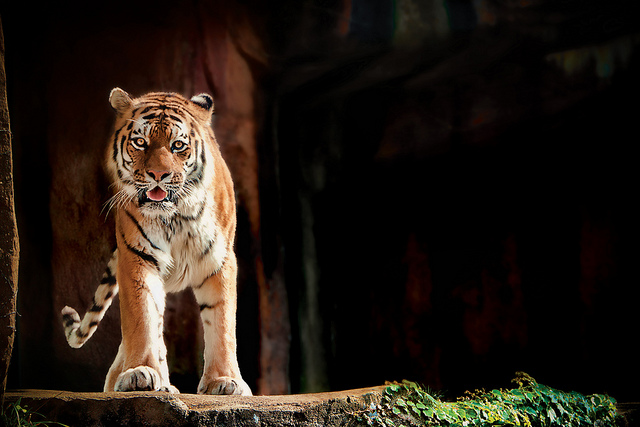
A Day at the Living Hoard¹
On a damp day, the loudest thing at the zoo is the AT&T Endangered Species carousel. A wooden Amur tiger leaps, frozen, around and around. The carousel’s gentle, repetitive music washes down the slope to where a real Amur tiger paces a small circuit. She pads quickly forward, her body flat and flexible when she turns back, then forward again, then back. Her mouth hangs open to show thick black lips and mottled pink gums. Deeper in the zoo, past the pacing Amur tiger and drowsy Macaque monkeys, are the red river hogs.
There is a patch of wild strawberries outside the north fence of the hog enclosure. The strawberries spread through the chain-link into the enclosure itself: a dark wet English green against a faded dusty ground. Right now two hogs ignore the strawberries to browse through sparse grass and fallen leaves, flipping flat stones with their gently flared, prehensile noses. One hog makes a staccato maneuver to settle on a layer of hay its counterpart has nosed into place. The hog shifts to mold the landscape of its back to the architecture of a false stone wall, and shifts again to mold to the other hog. Their heads are too broad and bumpy, nearly as long as their bodies. It is a challenge to get all that face to lie smoothly against and down.
When they sit end to end they are a range, blocky granite mountains with a white stripe along the ridge of their spine. Old riverbeds in their armpits, brush paths swaying their haunches, a dry lake for a curling ear. Black cave nostrils, crevasse hooves, tree hollow eyes, steep valley snout. A short sleek hillside of hair. Broadside gets the sun. A child, “Does it have a face?”
At the south side of the enclosure, the spectator’s left, another fence separates the hogs from the African painted dogs that patrol in tight trotting patterns. Occasionally a dog splashed black/tan/cream/brown will perk up and pause—its muzzle and face are dark, bearish, its oversized oval ears swiveled sharply forward—but then the sparrow it saw flies away.
People laugh at the dogs’ endless patterns the way they laugh at a child when it embarrasses itself but is too unselfconscious to know.
“He’s looking for lunch!” and,
“He wants to eat!” and,
“Hungry boys!”
They see the dogs’ agitation. They assume male and they assume hunger. The dogs make them aware of their own soft parts—meaty calves, warm belly, loose skin under their arms. There is a thrill at keeping the body safe and separate. Being scared of something and being scared for something can lead to the same captivity.
The African painted dogs never once look at the hogs a few feet away. When you spend years watching prey nose through strawberry patches and rub languidly on a huge bristle brush, does the docility—the way the food doesn’t snap your lithe legs into a chase, the way the food doesn’t incite your body to fulfill its life—rob you of your appetite? The distance between complacency and adaptation narrows.
The wind picks up and I realize there is no context outside captivity for my scent to blend with a wild dog or scavenging pig. Captivity creates a new world from old animals and old urges. Across the path from dog and hog, the European stork raises its bed-sheet wings and around the corner the tiger pants at the zoo’s entrance, their bodies exhaling from mouth and glands. No animal is more than a kilometer away from another. Surely they can smell each other. Surely all of them can smell each other on the breeze that comes off the lake and sweeps through the asphalt paths. But the wind jumbles all scents beyond recognition, sifts them through ever-expanding hands: erasure through accumulation. They don’t smell each other anymore, their noses made dim from overexposure, they don’t smell popcorn spilled on the asphalt, they don’t smell people leaning against the railing, and they don’t smell me. The hog that lies with its tight round stomach facing the fake rock wall heaves a sigh and flicks an ear against a raindrop. Soon, it will heave, get its legs under it, and trot under cover. All of us watching will, too.
¹Some animals store other animals but avoid spoilage by keeping prey alive and immobilized…Comatose prey neither escape nor spoil and retain nutritive value.–“Food Hoarding in Animals,” Stephen B. Vander Wall.
 Rebecca Nakaba is a writer and multimedia artist living in Chicago. Her work uses the biological and cosmological to explore the permeable boundaries between the body, self, and the natural and supernatural worlds. She has been published in The Meekling Review and Ghost Proposal. In 2017 she received the Mary Koga Memorial Fellowship, as well as the SAIC MFA in Writing Fellowship awarded by judge Paisley Rekdal.
Rebecca Nakaba is a writer and multimedia artist living in Chicago. Her work uses the biological and cosmological to explore the permeable boundaries between the body, self, and the natural and supernatural worlds. She has been published in The Meekling Review and Ghost Proposal. In 2017 she received the Mary Koga Memorial Fellowship, as well as the SAIC MFA in Writing Fellowship awarded by judge Paisley Rekdal.
STORY IMAGE CREDIT: Flickr Creative Commons/benisntfunny


